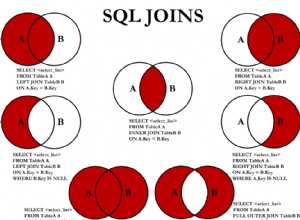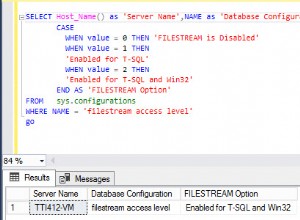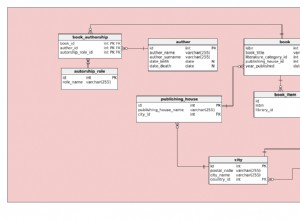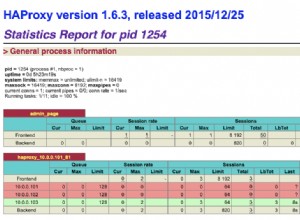Per testare la procedura che hai mostrato, dovresti fare qualcosa del tipo:
declare
l_id hr_position.id%type;
l_group_name hr_position.group_name%type;
l_group_level hr_position.group_level%type;
begin
drill_record_position('D', l_id, l_group_name, l_group_level);
dbms_output.put_line(l_id ||':'|| l_group_name ||':'|| l_group_level);
end;
/
Ma quello, o più specificamente, la tua procedura funziona solo se c'è esattamente una riga nel set di risultati della query per il tipo di valore passato. Sembra che ti aspetti più righe indietro (che otterrebbero troppe righe), ma potrebbero anche essercene non (che non otterrebbero dati trovati).
Quindi sembra davvero che la tua domanda dovrebbe riguardare come scrivere la tua procedura in modo che funzioni con uno dei metodi di recupero/test che hai provato.
Se la procedura deve restituire più righe, può utilizzare un cursore di riferimento, ad esempio:
create or replace procedure drill_record_position (
p_record_type in varchar2,
p_ref_cursor out sys_refcursor
)
as
begin
open p_ref_cursor for
select hr.id, hr.group_name, hr.group_level
from hr_position hr
join drill_position dp
on hr.id = dp.id
where dp.typevalue = p_record_type;
end drill_record_position;
/
che potresti quindi testare con qualcosa come:
declare
l_ref_cursor sys_refcursor;
l_id hr_position.id%type;
l_group_name hr_position.group_name%type;
l_group_level hr_position.group_level%type;
begin
drill_record_position('D', l_ref_cursor);
loop
fetch l_ref_cursor into l_id, l_group_name, l_group_level;
exit when l_ref_cursor%notfound;
dbms_output.put_line(l_id ||':'|| l_group_name ||':'|| l_group_level);
end loop;
close l_ref_cursor;
end;
/
Puoi anche farlo come una funzione, con cui potrebbe essere più facile lavorare dalla tua applicazione:
-- drop procedure drill_record_position;
create or replace function drill_record_position (p_record_type in varchar2)
return sys_refcursor as
l_ref_cursor sys_refcursor;
begin
open l_ref_cursor for
select hr.id, hr.group_name, hr.group_level
from hr_position hr
join drill_position dp
on hr.id = dp.id
where dp.typevalue = p_record_type;
return l_ref_cursor;
end drill_record_position;
/
declare
l_ref_cursor sys_refcursor;
l_id hr_position.id%type;
l_group_name hr_position.group_name%type;
l_group_level hr_position.group_level%type;
begin
l_ref_cursor := drill_record_position('D');
loop
fetch l_ref_cursor into l_id, l_group_name, l_group_level;
exit when l_ref_cursor%notfound;
dbms_output.put_line(l_id ||':'|| l_group_name ||':'|| l_group_level);
end loop;
close l_ref_cursor;
end;
/
Puoi farlo anche con le raccolte e una funzione pipeline, che richiede più lavoro da configurare:
create type t_drill_obj as object (
-- use your real data types...
id number,
group_name varchar2(10),
group_level number
)
/
create type t_drill_tab as table of t_drill_obj
/
create or replace function drill_record_position (p_record_type in varchar2)
return t_drill_tab pipelined as
begin
for l_row in (
select t_drill_obj(hr.id, hr.group_name, hr.group_level) as obj
from hr_position hr
join drill_position dp
on hr.id = dp.id
where dp.typevalue = p_record_type
)
loop
pipe row (l_row.obj);
end loop;
return;
end drill_record_position;
/
ma potresti chiamarlo come parte di un'altra query e persino unirti al risultato se necessario:
select * from table(drill_record_position('D'));




